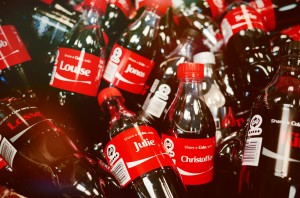The way we connect is shifting, consumers are moving swiftly (and some forcefully) into the digital space where many marketing relations are made through online campaigns.
Coke had their ingenious ‘Share a coke’ campaign where they individually branded bottles with 150 of the most common first names. The objective was to combat this virtual connectivity with their audience through offline means as well as online. The outcome was a boost in sales and increased talk-ability around the brand, both verbally and through photo shares of the consumer posing with their personalised coke bottle.

What’s in a Name?
It’s so simple, put a name on it and you instantly relate to a huge proportion of the market who have the same name, it may not be targeting specific demographics but it blasts the masses in one hit.
Have you noticed how over time the web pages you browse are becoming more personalised? Recently I was browsing an online shop and noticed a photo of a product that I’d been looking at buying on Amazon a few days before. How did Amazon infiltrate this unrelated shop? How do they know I want one but I’m undecided? For the weak-willed this is a terrible dilemma, one more mention and that’s it, you crack and the purchase is made!
The Stalking Marketer
Yesterday I saw an advert on Facebook in my news feed which showed a photo of hoodie with “it’s a Lucy thing” written on it. They couldn’t be any more blatant! It makes me think marketers are honing in on the narcissist side of human nature. If it’s got our name on it, it must be right for me as it’s clearly targeting me (and the other million people with the same name…). Some campaigns are very subtle, attempting to eat into our unconscious and influence our buying power. Others, like the name a hoddie campaign, are unashamedly transparent and show no attempt at disguising the sales pitch.
Research was released following the launch of the IPhone 6 (great timing), where they announced Apple as the coolest brand, alongside a list of other major players. If it’s got a fashionable name attached then there’s an appeal to buy, therefore the consumer is associated with the brands reputation. It’s unconscious in some people – you may insist on branded products when you know the value option is probably exactly the same. For some people it’s a conscience option, they desire the connection.
Brands with a Reputation
As a child on our yearly family holidays to Europe, I remember my mum buying t-shirts from the market with Calvin Klein plastered across the front in large font. They were appalling quality as they were fake and often the name was spelt incorrectly! But all of the tourists lapped up the branded clothing.
Inbound marketing has progressed rapidly. Previously, using software to include the receiver’s first name on a mass email was the common way to connect personally. Now brands want to be more specific and target you with items relevant to your interests, hobbies and shopping habits.
We’re moving into a space where we can communicate with our audience on a more personalised level for those that we cannot have face-to-face contact. No one wants to receive content that’s aimed at the masses, there’s enough to filter through already. The consumer wants relevant and appropriate material that meets their needs, not another fake relationship with a meaningless connection.
Lucy Helliwell










